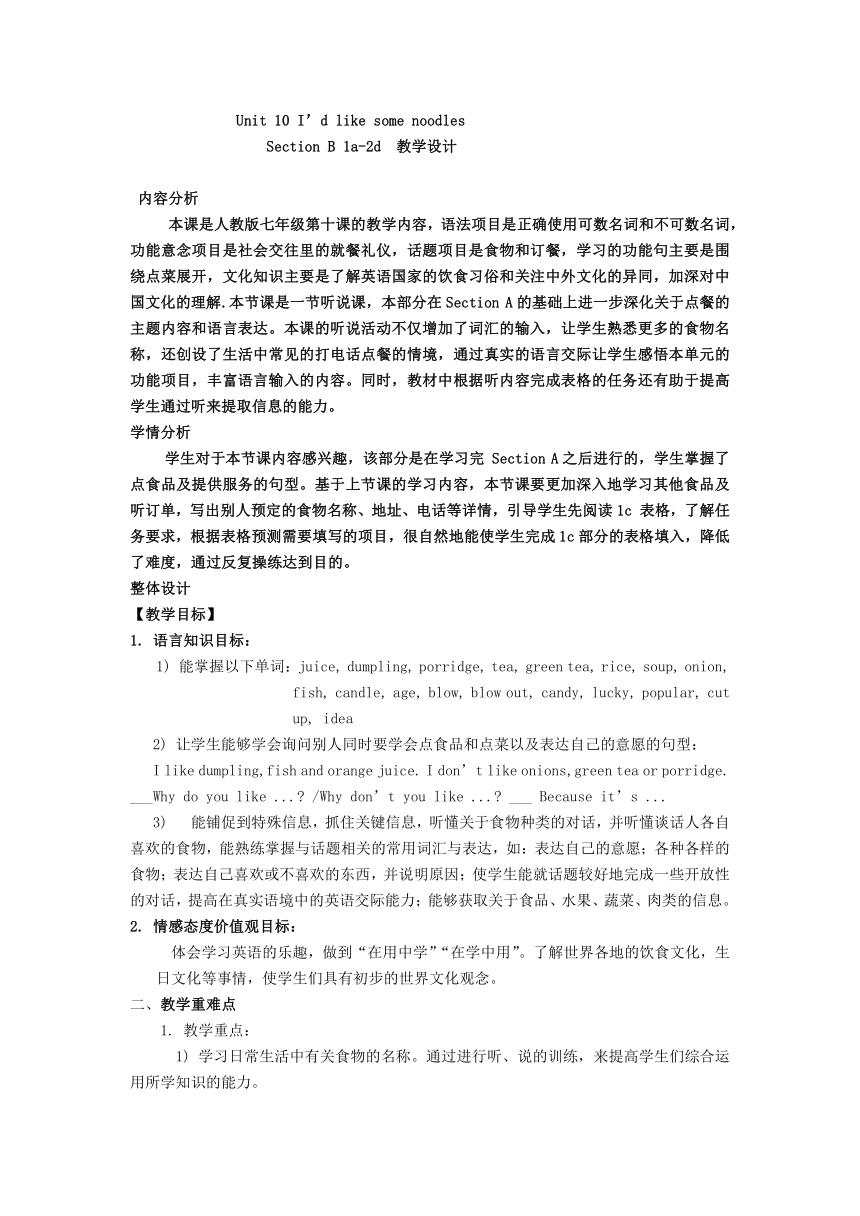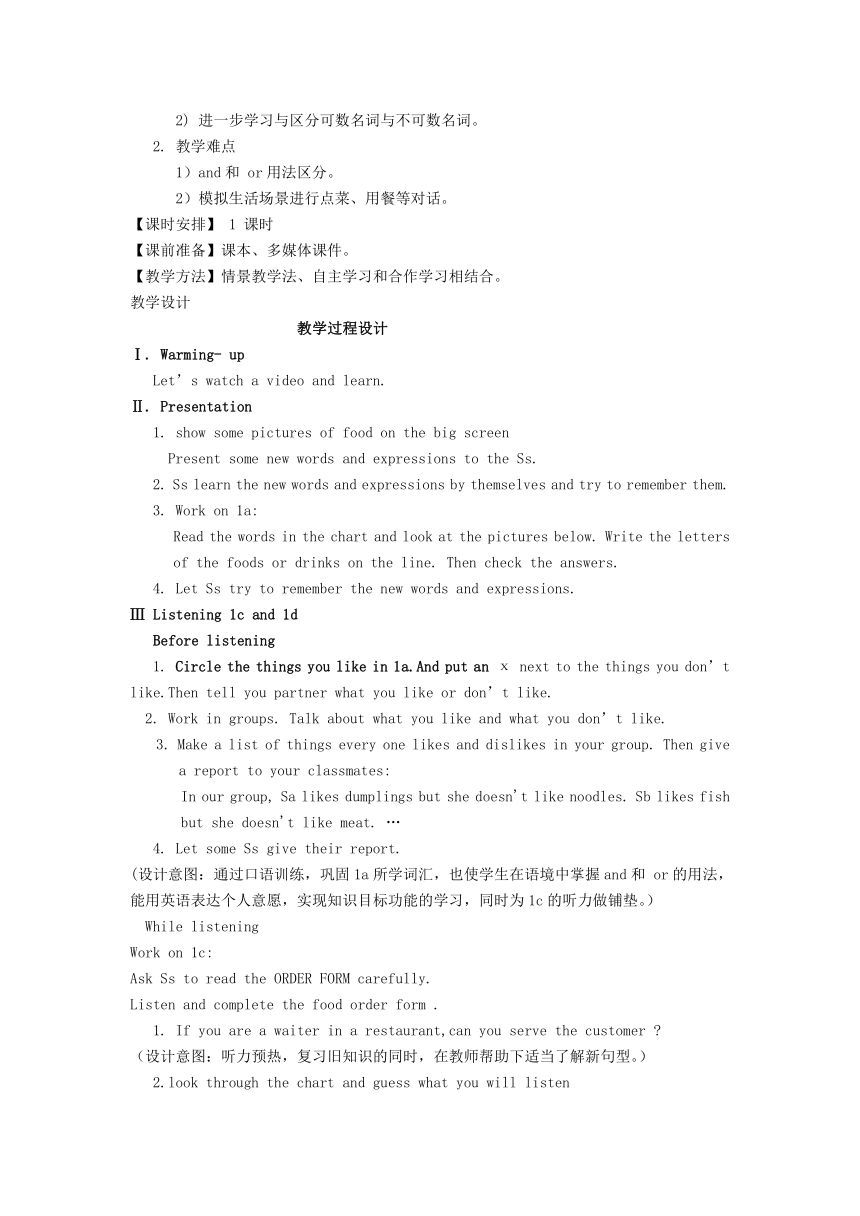人教版七年级下册 Unit 10 I’d like the noodles. Section B 教案(表格式)
文档属性
| 名称 | 人教版七年级下册 Unit 10 I’d like the noodles. Section B 教案(表格式) |  | |
| 格式 | zip | ||
| 文件大小 | 19.5KB | ||
| 资源类型 | 教案 | ||
| 版本资源 | 人教新目标(Go for it)版 | ||
| 科目 | 英语 | ||
| 更新时间 | 2023-01-20 21:44:03 | ||
图片预览


文档简介
Unit 10 I’d like some noodles
Section B 1a-2d 教学设计
内容分析
本课是人教版七年级第十课的教学内容,语法项目是正确使用可数名词和不可数名词,功能意念项目是社会交往里的就餐礼仪,话题项目是食物和订餐,学习的功能句主要是围绕点菜展开,文化知识主要是了解英语国家的饮食习俗和关注中外文化的异同,加深对中国文化的理解.本节课是一节听说课,本部分在Section A的基础上进一步深化关于点餐的主题内容和语言表达。本课的听说活动不仅增加了词汇的输入,让学生熟悉更多的食物名称,还创设了生活中常见的打电话点餐的情境,通过真实的语言交际让学生感悟本单元的功能项目,丰富语言输入的内容。同时,教材中根据听内容完成表格的任务还有助于提高学生通过听来提取信息的能力。
学情分析
学生对于本节课内容感兴趣,该部分是在学习完 Section A之后进行的,学生掌握了点食品及提供服务的句型。基于上节课的学习内容,本节课要更加深入地学习其他食品及听订单,写出别人预定的食物名称、地址、电话等详情,引导学生先阅读1c 表格,了解任务要求,根据表格预测需要填写的项目,很自然地能使学生完成1c部分的表格填入,降低了难度,通过反复操练达到目的。
整体设计
【教学目标】
1. 语言知识目标:
1) 能掌握以下单词:juice, dumpling, porridge, tea, green tea, rice, soup, onion, fish, candle, age, blow, blow out, candy, lucky, popular, cut up, idea
2) 让学生能够学会询问别人同时要学会点食品和点菜以及表达自己的意愿的句型:
I like dumpling,fish and orange juice. I don’t like onions,green tea or porridge. ___Why do you like ... /Why don’t you like ... ___ Because it’s ...
能铺促到特殊信息,抓住关键信息,听懂关于食物种类的对话,并听懂谈话人各自喜欢的食物,能熟练掌握与话题相关的常用词汇与表达,如:表达自己的意愿;各种各样的食物;表达自己喜欢或不喜欢的东西,并说明原因;使学生能就话题较好地完成一些开放性的对话,提高在真实语境中的英语交际能力;能够获取关于食品、水果、蔬菜、肉类的信息。
2. 情感态度价值观目标:
体会学习英语的乐趣,做到“在用中学”“在学中用”。了解世界各地的饮食文化,生日文化等事情,使学生们具有初步的世界文化观念。
二、教学重难点
1. 教学重点:
1) 学习日常生活中有关食物的名称。通过进行听、说的训练,来提高学生们综合运用所学知识的能力。
2) 进一步学习与区分可数名词与不可数名词。
2. 教学难点
1)and和 or用法区分。
2)模拟生活场景进行点菜、用餐等对话。
【课时安排】 1 课时
【课前准备】课本、多媒体课件。
【教学方法】情景教学法、自主学习和合作学习相结合。
教学设计
教学过程设计
Ⅰ. Warming- up
Let’s watch a video and learn.
Ⅱ. Presentation
1. show some pictures of food on the big screen
Present some new words and expressions to the Ss.
2. Ss learn the new words and expressions by themselves and try to remember them.
3. Work on 1a:
Read the words in the chart and look at the pictures below. Write the letters of the foods or drinks on the line. Then check the answers.
4. Let Ss try to remember the new words and expressions.
Ⅲ Listening 1c and 1d
Before listening
Circle the things you like in 1a.And put an х next to the things you don’t like.Then tell you partner what you like or don’t like.
2. Work in groups. Talk about what you like and what you don’t like.
3. Make a list of things every one likes and dislikes in your group. Then give a report to your classmates:
In our group, Sa likes dumplings but she doesn't like noodles. Sb likes fish but she doesn't like meat. …
Let some Ss give their report.
(设计意图:通过口语训练,巩固1a所学词汇,也使学生在语境中掌握and和 or的用法,能用英语表达个人意愿,实现知识目标功能的学习,同时为1c的听力做铺垫。)
While listening
Work on 1c:
Ask Ss to read the ORDER FORM carefully.
Listen and complete the food order form .
1. If you are a waiter in a restaurant,can you serve the customer
(设计意图:听力预热,复习旧知识的同时,在教师帮助下适当了解新句型。)
2.look through the chart and guess what you will listen
3. Now let’s listen to the conversation and write down the customer’s address,telephone number and what he orders
(设计意图:通过此次活动实现技能目标中听与写的目标)
4. Listen again, check the answers,and see which group is better.
After listening
1. Listen to the conversation and repeat.
(设计意图:听力模仿,一方面提醒学生注意语音语调,另一方面,巩固订餐常用句型,为下一步语音输出做准备,实现技能目标中读的要求。)
2. Pair work:Practice the conversation in pairs and then ask some pairs to act out their conversations
(设计意图:创设真实情境,让学生在语境中掌握电话订餐的方式方法及常用句型,实现技能目标中说的要求。)
观察与思考
语法:不可数名词,不能用数来计算,没有复数形式也不能与a /an直接连用;表达数量时,要借助量词,如:
A cup of tea two ___ ___ ___
A bottle of milk four ___ ___ ___
A piece of bread many ___ ___ ___
A bag of rice some ___ ___ ___
不可数名词也可以用some, much, little, a little, a lot of来修饰,如:some rice;much money.
There is a pair of shoes
There are two pairs of shoes
谓语动词的选择要根据量词。
(设计意图:明确可数名词与不可数名词,单词正确分类,巩固Grammar Focus的语法内容,也为下一步1b准确的语言输出打下基础,实现知识目标词汇及语法的学习。)
Ⅳ. Group work
1. Work in groups. Discuss what do you do or eat on your birthday
2. Ss take turns to talk about it.
S1: I usually get many nice gifts from my parents. I usually have a nice dinner in a restaurant.
S2: My parents usually buy me some nice books and school things on my birthday.
S3: ….
3. Write down what your group members do on their birthday. And give a report to the class.
In my group, S1… S2… S3…
课堂小结
学生先独立思考,然后以小组合作的形式进行讨论:
通过本节课的学习,你能说出 and和or的练习与区别吗
And 和 or都是并列连词。表示几个事物、人或动物是并列关系时,肯定句中用____________ , 疑问句和否定句中用________________ .
(2) 通过本节课的学习,我们又学到或复习的点餐问句有哪些 ?______________________________ .
教师总结:本节课我们主要学习了一些食物词汇,如:juice, dumpling, porridge, tea, green tea, rice, soup, onion,fish,并学习了新的句型,如: I like dumplings,fish and orange juice. I don’t like onions,green tea or porridge. 等,同时加强了听力和口语的训练。
课后作业
口头作业:1. 听读每节课的词汇。 2. 跟读1c录音材料,熟悉掌握目标句型。
书面作业:1. Write the words and expressions in this period.
2. Write an article about your favorite food.
板书设计
Unit 10 I’d like some noodles
Section B 1a-1d
I’d like ... , ... and ... I don’t like ... ,...or ...
What kind of dumplings would you like ?
What’s your address,please
What’s your telephone number,please
教学反思
本课是听说课,词汇的拓展和1b口头练习为后面的听力做了充分的准备,降低了听力的难度。听力1c填表的内容过多,听力过程中学生记录不是很好,应该多听几遍。学生的口语输出活动,激发了学生的兴趣,在愉快气氛下较好地掌握了本节课的内容。
本节课中也有以下改进的地方:
学生听力填表的正确率不高,应当分解听力任务,即:分2--3个步骤来填表。
听力过程输入不充分造成听后的输出不理想,不能忽视听后对听力材料的再消化。
Section B 1a-2d 教学设计
内容分析
本课是人教版七年级第十课的教学内容,语法项目是正确使用可数名词和不可数名词,功能意念项目是社会交往里的就餐礼仪,话题项目是食物和订餐,学习的功能句主要是围绕点菜展开,文化知识主要是了解英语国家的饮食习俗和关注中外文化的异同,加深对中国文化的理解.本节课是一节听说课,本部分在Section A的基础上进一步深化关于点餐的主题内容和语言表达。本课的听说活动不仅增加了词汇的输入,让学生熟悉更多的食物名称,还创设了生活中常见的打电话点餐的情境,通过真实的语言交际让学生感悟本单元的功能项目,丰富语言输入的内容。同时,教材中根据听内容完成表格的任务还有助于提高学生通过听来提取信息的能力。
学情分析
学生对于本节课内容感兴趣,该部分是在学习完 Section A之后进行的,学生掌握了点食品及提供服务的句型。基于上节课的学习内容,本节课要更加深入地学习其他食品及听订单,写出别人预定的食物名称、地址、电话等详情,引导学生先阅读1c 表格,了解任务要求,根据表格预测需要填写的项目,很自然地能使学生完成1c部分的表格填入,降低了难度,通过反复操练达到目的。
整体设计
【教学目标】
1. 语言知识目标:
1) 能掌握以下单词:juice, dumpling, porridge, tea, green tea, rice, soup, onion, fish, candle, age, blow, blow out, candy, lucky, popular, cut up, idea
2) 让学生能够学会询问别人同时要学会点食品和点菜以及表达自己的意愿的句型:
I like dumpling,fish and orange juice. I don’t like onions,green tea or porridge. ___Why do you like ... /Why don’t you like ... ___ Because it’s ...
能铺促到特殊信息,抓住关键信息,听懂关于食物种类的对话,并听懂谈话人各自喜欢的食物,能熟练掌握与话题相关的常用词汇与表达,如:表达自己的意愿;各种各样的食物;表达自己喜欢或不喜欢的东西,并说明原因;使学生能就话题较好地完成一些开放性的对话,提高在真实语境中的英语交际能力;能够获取关于食品、水果、蔬菜、肉类的信息。
2. 情感态度价值观目标:
体会学习英语的乐趣,做到“在用中学”“在学中用”。了解世界各地的饮食文化,生日文化等事情,使学生们具有初步的世界文化观念。
二、教学重难点
1. 教学重点:
1) 学习日常生活中有关食物的名称。通过进行听、说的训练,来提高学生们综合运用所学知识的能力。
2) 进一步学习与区分可数名词与不可数名词。
2. 教学难点
1)and和 or用法区分。
2)模拟生活场景进行点菜、用餐等对话。
【课时安排】 1 课时
【课前准备】课本、多媒体课件。
【教学方法】情景教学法、自主学习和合作学习相结合。
教学设计
教学过程设计
Ⅰ. Warming- up
Let’s watch a video and learn.
Ⅱ. Presentation
1. show some pictures of food on the big screen
Present some new words and expressions to the Ss.
2. Ss learn the new words and expressions by themselves and try to remember them.
3. Work on 1a:
Read the words in the chart and look at the pictures below. Write the letters of the foods or drinks on the line. Then check the answers.
4. Let Ss try to remember the new words and expressions.
Ⅲ Listening 1c and 1d
Before listening
Circle the things you like in 1a.And put an х next to the things you don’t like.Then tell you partner what you like or don’t like.
2. Work in groups. Talk about what you like and what you don’t like.
3. Make a list of things every one likes and dislikes in your group. Then give a report to your classmates:
In our group, Sa likes dumplings but she doesn't like noodles. Sb likes fish but she doesn't like meat. …
Let some Ss give their report.
(设计意图:通过口语训练,巩固1a所学词汇,也使学生在语境中掌握and和 or的用法,能用英语表达个人意愿,实现知识目标功能的学习,同时为1c的听力做铺垫。)
While listening
Work on 1c:
Ask Ss to read the ORDER FORM carefully.
Listen and complete the food order form .
1. If you are a waiter in a restaurant,can you serve the customer
(设计意图:听力预热,复习旧知识的同时,在教师帮助下适当了解新句型。)
2.look through the chart and guess what you will listen
3. Now let’s listen to the conversation and write down the customer’s address,telephone number and what he orders
(设计意图:通过此次活动实现技能目标中听与写的目标)
4. Listen again, check the answers,and see which group is better.
After listening
1. Listen to the conversation and repeat.
(设计意图:听力模仿,一方面提醒学生注意语音语调,另一方面,巩固订餐常用句型,为下一步语音输出做准备,实现技能目标中读的要求。)
2. Pair work:Practice the conversation in pairs and then ask some pairs to act out their conversations
(设计意图:创设真实情境,让学生在语境中掌握电话订餐的方式方法及常用句型,实现技能目标中说的要求。)
观察与思考
语法:不可数名词,不能用数来计算,没有复数形式也不能与a /an直接连用;表达数量时,要借助量词,如:
A cup of tea two ___ ___ ___
A bottle of milk four ___ ___ ___
A piece of bread many ___ ___ ___
A bag of rice some ___ ___ ___
不可数名词也可以用some, much, little, a little, a lot of来修饰,如:some rice;much money.
There is a pair of shoes
There are two pairs of shoes
谓语动词的选择要根据量词。
(设计意图:明确可数名词与不可数名词,单词正确分类,巩固Grammar Focus的语法内容,也为下一步1b准确的语言输出打下基础,实现知识目标词汇及语法的学习。)
Ⅳ. Group work
1. Work in groups. Discuss what do you do or eat on your birthday
2. Ss take turns to talk about it.
S1: I usually get many nice gifts from my parents. I usually have a nice dinner in a restaurant.
S2: My parents usually buy me some nice books and school things on my birthday.
S3: ….
3. Write down what your group members do on their birthday. And give a report to the class.
In my group, S1… S2… S3…
课堂小结
学生先独立思考,然后以小组合作的形式进行讨论:
通过本节课的学习,你能说出 and和or的练习与区别吗
And 和 or都是并列连词。表示几个事物、人或动物是并列关系时,肯定句中用____________ , 疑问句和否定句中用________________ .
(2) 通过本节课的学习,我们又学到或复习的点餐问句有哪些 ?______________________________ .
教师总结:本节课我们主要学习了一些食物词汇,如:juice, dumpling, porridge, tea, green tea, rice, soup, onion,fish,并学习了新的句型,如: I like dumplings,fish and orange juice. I don’t like onions,green tea or porridge. 等,同时加强了听力和口语的训练。
课后作业
口头作业:1. 听读每节课的词汇。 2. 跟读1c录音材料,熟悉掌握目标句型。
书面作业:1. Write the words and expressions in this period.
2. Write an article about your favorite food.
板书设计
Unit 10 I’d like some noodles
Section B 1a-1d
I’d like ... , ... and ... I don’t like ... ,...or ...
What kind of dumplings would you like ?
What’s your address,please
What’s your telephone number,please
教学反思
本课是听说课,词汇的拓展和1b口头练习为后面的听力做了充分的准备,降低了听力的难度。听力1c填表的内容过多,听力过程中学生记录不是很好,应该多听几遍。学生的口语输出活动,激发了学生的兴趣,在愉快气氛下较好地掌握了本节课的内容。
本节课中也有以下改进的地方:
学生听力填表的正确率不高,应当分解听力任务,即:分2--3个步骤来填表。
听力过程输入不充分造成听后的输出不理想,不能忽视听后对听力材料的再消化。
同课章节目录
- Unit 1 Can you play the guitar?
- Section A
- Section B
- Unit 2 What time do you go to school?
- Section A
- Section B
- Unit 3 How do you get to school?
- Section A
- Section B
- Unit 4 Don't eat in class.
- Section A
- Section B
- Unit 5 Why do you like pandas?
- Section A
- Section B
- Unit 6 I'm watching TV.
- Section A
- Section B
- Review of Units 1-6
- Unit 7 It's raining!
- Section A
- Section B
- Unit 8 Is there a post office near here?
- Section A
- Section B
- Unit 9 What does he look like?
- Section A
- Section B
- Unit 10 I'd like some noodles.
- Section A
- Section B
- Unit 11 How was your school trip?
- Section A
- Section B
- Unit 12 What did you do last weekend?
- Section A
- Section B
